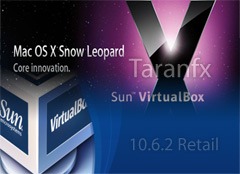
After 2 months of experiments, fighting in the dark, and with help from black Trinitron, the work is done and I think its time to reveal it.
Who doesn’t love Open Source? And when a Open source product is better than a paid application, we adore it. So is the case with Virtualbox. Virtualbox 3.1 is an amazing platform for Virtualization, It’s not only free, but also much faster than VMware in Disk I/O, Network I/O, RAM optimization, CPU Usage, Hypervisor level operations. Hats off to Sun–Oracle.
Note: This is a Retail installation guide, hence little more tricky. If you don’t mind an osx86 distro inside virtualbox and want ease of installation, tryout Install Mac OS X Hackintosh in VirtualBox [Snow Leopard] instead.
Before you begin, make sure you have enough CPU, RAM, Disk resources to share for the virtual machine.
Hardware Requirements:
- Processor: Any Intel Processor with VT-x (Virtualization Technology) or AMD-V. (Almost all Intel processors starting from Core 2 Duo, Quad, etc. support it) Ask us, if you still have a doubt: @geeknizer.
- RAM: Anything above 1 GB, Recommended 2GB or higher
- Disk space: 10GB (minimum)
Software Requirements:
- Snow Leopard Retail Disc (or ISO). We recommend you buy Original, don’t pirate!
- A OSx86 Leopard Distro – Any OS X 10.5.x iDeneb, iAtkos, etc. (I had bad time with Kalyway) iDeneb v1.3 (10.5.5) worked great for me. (and iAtkos 10.5.7 as reported by a commenter)
- Virtualbox 3.1.2 (Download)
- Bit of Patience 🙂
Brief: We will be installing Osx86 Leopard then upgrading to Snow Leopard Retail, that is 100% upgradeable to 10.6.2 and Works on Windows XP, Windows Vista, Windows 7. Alternatively, You can install Snow Leopard directly via an OSx86 Distro like SnowOSX (but that won’t be upgradeable, unless you use SnowOSX v3.6 which is already 10.6.2. But the upcoming 10.6.3 update won’t be possible). So let’s go the usual way (Leopard then Snow Leopard Retail), though it’s upto you to choose.
Let’s Get started:
Phase I: Install Leopard on Virtualbox
Step 1. Create a new Virtual Machine with name “Leopard”:
- System Type: BSD, FreeBSD
- Create Disk (10 GB will suffice) with name “Leofx”
- System > Motherboard > Enable IO APIC
- (optional) Processor 2 or 4 (Dual Core, Quad core)
- Acceleration > Enable VT-x/AMD-V
- Storage > IDE Controller – ICH6
- Attach New CD drive > select image (OSx86 Leopard)
- Hit Ok
Step 2. Open Virtual machine xml.
Windows 7: C:\Users\fx<Your User>\.VirtualBox\Machines\Snow\Snow.xml
Windows XP: C:\Documents and Settings\fx<YourUser>\.VirtualBox\Machines\Snow\Snow.xml
Add string to the section <ExtraData> for the XML:
<ExtraDataItem name="VBoxInternal2/SupportExtHwProfile" value="on"/>
Step 3. Switch on Virtual Machine and install Leopard distro as-usual. (You can check Install Leopard on PC guide, if you are new to OSx86).
Alright, Leopard setup would succeed and is up and running after reboot.(Make sure you change boot priority to “Leo” Hard disk in VM settings).
Stuck somewhere? Get in touch @geeknizer on Twitter.
For installing Snow Leopard, proceed to Phase II
Phase II. Installing Snow Leopard
Step 1. Close VirtualBox and patch it with files from here (32 bit) and here (64 bit)
Update: I heard Virtualbox 3.1.4 Beta works out of the box, without patching. I haven’t tried that though.
Step 2. Attach the following Three disks to the virtual machine under “Storage” tab:
- Attach A new Disk (10 GB minimum) with name “Snow”.
- DVD drive, if you plan to use Snow Leopard Retail disk OR The Retail image. (use PowerISO to convert DMG to ISO).
- Download and attach this Addon Util image[iso]. (contains few Kexts, utils).
Step 3. Boot Leopard and Launch Disk Utility (Applications > Utilties ) and Format the new “Snow” with “Mac OS Journaled”
Step 4. From the addon image “MacUtils”, Run “unHideIt” and then browse to /System/Installation/Packages( inside Retail disc) and run OSInstall.mpkg
Step 5. Select “Snow” disk and customize install to remove unnecessary packages (languages, printers) and Install. Installation should finish without any problems.
Step 6. Install Chameleon from the “MacUtils” on to “Snow” drive. [How to Install Chameleon]
Beyond this point, all changes are made to /Volumes/Snow
Step 7. Let’s setup some drivers:
- Remove all stuff from /Extra/Extensions
- Copy “Mac Utils”/Mac/Extra/Extensions to Extra/Extensions
- Copy “Mac Utils”/Mac/System/Library/Extensions to System/Library/Extensions
- Navigate to System/Library/Extensions and delete “AppleIntelCPUPowerManagement.kext”
Step 8. Fix permissions by using Terminal (from Applications > Utilities):
su cd /Volumes/Snow/System/Library chown -R root:wheel Extensions/ cd /Volumes/Snow/Extra chown -R root:wheel Extensions/ kextcache -a x86_64 -K /Volumes/Snow/mach_kernel -m /Volumes/Snow/System/Library/Extensions.mkext /Volumes/Snow/System/Library/Extensions kextcache -a x86_64 -K /Volumes/Snow/mach_kernel -m /Volumes/Snow/Extra/Extensions.mkext /Volumes/Snow/Extra/Extensions
Nice! Hold down your patience we are almost done.
Now, Shutdown Leopard and move on to Final Phase
Phase III: Creating Snow Leopard machine
Step 1. Alright, Let’s create a new Virtual Machine, name it “Snowfx” or whatever you wish to. Create it exactly as we did in Phase I : Step 1. Only additional step is t configure Networking:
- Network > Adapter 1 > Attached to “Bridged Adapter”
- Advanced > Adapter Type > Select “Intel PRO/1000 MT server”
And add the following to Snow Machine XML:
<ExtraDataItem name="VBoxInternal/Devices/e1000f/0/Trusted" value="integer:1"/> <ExtraDataItem name="VBoxInternal/PDM/Devices/PcExt/Path" value="VBoxDD3"/>
Step 2. Run the Virtual Machine and you will land into desktop with everything (including internet) working.
Note: If your mouse doesn’t work use this Kext. For me it worked as-is.
Go ahead and update to 10.6.2. And when the upcoming 10.6.3 is released, you will be able to upgrade without issues.
There you are, running the latest Snow Leopard, sweet! Enjoy the speed and cost benefits VirtualBox has to offer, Praise the Sun and love Open Source 😀
We write latest and greatest in Tech Guides, Hackintosh, Apple, iPhone, Tablets, Android, Open Source, Latest in Tech, subscribe to us@geeknizer on Twitter OR on Facebook Fanpage:
